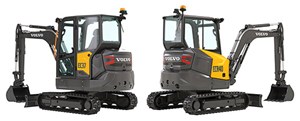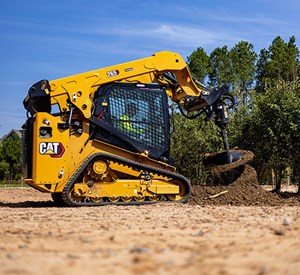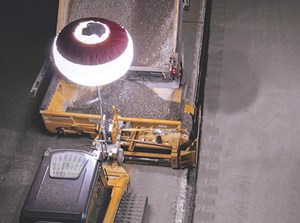February 2024 Vol. 79 No. 2
New Products
New Products
United Rentals
unitedrentals.com
United Rentals Inc. unveiled the Estimated Emissions dashboard, a groundbreaking digital tool that enables users to view rental equipment and job sites through the lens of current and historical estimated carbon emissions. The tool is available through the United Rentals cloud-based fleet management platform, Total Control.
The Estimated Emissions dashboard helps customers understand their equipment emissions and make data-based decisions to enact changes that will yield the most significant results.
Users can view estimated emissions data – specifically, estimated metric tons of carbon dioxide equivalent – by equipment category class, time or job site. From any view, users can filter the data by time period (such as current month, previous month, year-to-date and previous year), account, job site and cat class.
Each view provides helpful data cards highlighting important information, such as total estimated emissions of all rental equipment, highest estimated emissions in a single month, and cat class with the highest total estimated emissions.
"Reducing job-site emissions is a priority for many construction companies and project owners, but it is difficult to manage what you cannot measure," said Tony Leopold, senior vice president of Strategy & Digital, United Rentals.
"Access to easily digestible, shareable data on estimated emissions is the first step in the drive to reduce a jobsite's carbon footprint. With the Estimated Emissions dashboard in Total Control, United Rentals puts this data, and the power to act on it, at our customers' fingertips."
Volvo
volvoce.com
Volvo Construction Equipment introduced two new compact excavators to North America: the 3.5-ton EC37 and 4-ton ECR40. Featuring increased operator comfort, 10-percent more fuel efficiency, better stability and easier maintenance, these models replace the EC35D, ECR35D and ECR40D.
“The 3- to 4-ton size makes up more than a quarter of the compact excavator market in North America, and we’re excited to refresh our offering in that range,” said Darren Ashton, product manager — compact equipment, Volvo CE.
This duo shares the same platform and components, though EC37 has a conventional upper carriage design and ECR40 has a short swing radius to allow for work in more confined spaces.
The new EC37 and ECR40 excavators give operators a spacious, ergonomic and quiet cab. It provides outstanding visibility thanks to slim corner pillars and wide, flat glass areas. For added comfort, the armrest and controls float with the seat, and the door opening and travel pedals are larger than in previous models.
The intuitive jog wheel and easy-to-navigate HMI (human machine interface) functionalities provide controllability and adaptability for any job requirements. Work modes now include an ECO mode and an auto engine shutdown, in addition to the existing auto engine idle.
With auto engine shutdown, hours not worked are not recorded, keeping the machine operating efficiently for longer, while reducing maintenance costs. This also contributes to a 10-percent boost in fuel efficiency.
Because of the customizable hydraulics flow setting and work modes for a wide range of attachments and applications, it is easier than ever to set up these excavators for any task. If there are multiple operators working with the same machine, each person can set up the controls however they see fit with a few simple setting changes on the new 5-inch HMI.
The EC37 and ECR40 include a new elongated undercarriage for optimum stability in almost any environment, thanks to the better weight balance provided by longer contact between the tracks and the ground. The adjusted center of gravity reduces the “rocking-chair effect” other compact excavators may create.
These new machines boast 50-hour greasing intervals and an 18.5-gallon fuel tank capacity. The patented multifunction hydraulic oil filter provides outstanding protection to the hydraulic system. The engine and rear hoods feature wide openings, and the engine doesn’t require a diesel particulate filter.
Caterpillar
Building on D3 series compact track loader success, the all-new, next generation Cat 255 and 265 are a ground-up redesign of the previous series, improving on the features that made the previous models so popular. The first next generation models in the compact track loader line, the 255 and 265 elevate Caterpillar’s loader reputation through improved engine performance, lift and tilt performance, stability, operator comfort and technology.
The new 255 and 265 loaders are powered by Cat C2.8T and Cat C2.8TA engines, respectively, which offer 74.3 horsepower (55.4 kW). The new engines maintain horsepower across a wider RPM range and boast significant torque increases – gains of 13 percent for the 255 and 43 percent for the 265 – for improved working performance.
A redesigned engine compartment mounts the engine and cooling package lower into the frame for enhanced stability, giving the operator confidence in handling heavy loads and throughout all aspects of the work cycles.
The new 255 loader delivers class-leading lift height, and compared to the 259D3, 36-percent more tilt breakout, 26-percent higher lift breakout force and a 24-percent increase in rated operating capacity (ROC).
Height to the B-pin for the 265, compared to the 289D3, increases by 7.6 inches (193 mm), resulting in a class-leading maximum lift height of 11 feet (3.35 m) for easier truck loading. The 265 also delivers 19-percent higher tilt breakout force and 22-percent higher lift breakout force.
Standard hydraulic system pressure is increased to 3,500 psi (24130 kPa). New for these next generation machines, the closed-center auxiliary hydraulic system allows the 255 and 265 to operate all Cat Smart Attachments, including the Cat Smart Dozer Blade, with the standard auxiliary hydraulics provided.
Machines equipped with Standard Flow are shipped from the factory outfitted as “High Flow ready.” This functionality is easily activated via a new software enabled attachment (SEA), permitting on-machine or remote activation of increased hydraulic flow to 30 gallons per minute (113 l/min) at the standard system pressure.
The High Flow XPS factory option increases auxiliary hydraulic system pressure to 4061 pounds per square inch (28000 kPa) for both models, while also increasing the hydraulic flow to 30 gallons/minute (113 l/min) for the 255, and 34 gallons/minute (129 l/min) for the 265. The 255 equipped with the High Flow XPS option offers customers class-leading auxiliary hydraulic performance not available before in a mid-size chassis machine.
Reengineering of lower machine components results in a stronger and stiffer undercarriage for improved machine stability and less pitching when filling the bucket with material. Its torsion suspension undercarriage delivers better operator comfort, track wear and material retention, plus the stiffer design results in smoother graded surfaces. The 255 loader offers a new 12.6-inch (320-mm) bar-tread narrow track option.
Road Widener
Road Widener LLC enhances utility trench backfilling applications, with the patented FH-R material placement attachment.
Enhancing the efficiency, safety and quality of utility trench backfilling processes, it can accomplish what traditional equipment does in a fraction of the time by precisely dispensing topsoil, gravel, asphalt and more.
The remote-controlled attachment only requires one crewmember and easily connects to most skid steers, compact track loaders, road graders and wheel loaders, operating off the host machine’s engine and hydraulics. No engine or transmission to maintain reduces maintenance by 90 percent over self-propelled machines.
“The FH-R cuts out job-site clutter and enhances efficiency by eliminating extra machines and reducing the multi-step process down to just two passes, dispensing and compacting,” said Jeremy Dehnel, director of sales. “Utility contractors will get a high-quality, profitable and efficient solution for their business that makes for an unrivaled total cost of ownership.”
Available in left-, right- or dual-dispensing configurations, FH-R streamlines common utility construction tasks including trench backfilling. It works seamlessly with a variety of materials, ranging from topsoil and aggregate to gravel, asphalt and more.
Material is poured into the hopper at the top of the FH-R and then precisely dispensed via remote control in adjustable lay-down widths from 1 to 6 feet (.3 to 1.8 meters). The attachment dispenses up to 20 tons of material in under 10 minutes, without the need for any additional scraping or sweeping. Thanks to its remote-control technology, Road Widener customers have reported up to 50-percent savings in labor costs.
“Crews will be more efficient and see immediate ROI with the FH-R,” Dehnel said. “Typically, backfilling a utility line trench could involve a tedious four-step process, where a machine piles material on the trench and large crews scrape, push and sweep it into place. The FH-R cuts out half of those steps by placing the material right where it needs to go the first time.”
The FH-R works with standard and high-flow hydraulics and has only five grease fittings to maintain. Without an engine, powertrain or any associated parts of its own to service, it requires 90-percent less maintenance than self-propelled machines. Additionally, FH-R is available with an optional universal mounting plate to ensure smooth compatibility and connection.
The compact design of FH-R fits on the same commercial trailer as the host machine and can be towed by a common pickup truck. Additionally, its small footprint decreases traffic disturbance and danger on busy highways and narrow backroads. And, with a 360-degree swivel caster, FH-R can easily maneuver around posts, guard rails or any common objects. It can also be purchased in an all-manual configuration, the FH, without a remote.
Each FH-R includes a one-year warranty. Road Widener offers a variety of attachments designed to seamlessly fit onto existing equipment and significantly improve trench backfilling productivity and the bottom-line.
VMT
In 2020, VMT launched the TUnIS Navigation MT, which for the first time, combined machine guidance with laser and target, hydrostatic level, gyroscope, as well as moving laser total station tunnel navigation systems, into one product. The system guarantees the greatest possible flexibility and efficiency when managing projects.
When using the navigation system for curved and long-distance drives (gyro- or laser-total-station-based), manual control measurements were necessary to maintain the accuracy of the alignment. Typically, a traverse measurement from the launch shaft through the pipeline up to the machine is measured manually, and reference points then determine which are used for the calibration of the navigation system.
This has become particularly problematic with the growing requirement for longer drives in critical diameters of ≤1,200 mm, in the microtunneling and Direct Pipe sectors – where entry of personnel into the pipeline is difficult or even not allowed. Pipe jacking or Direct Pipe projects with pipe or pipeline diameters of ≤1,200mm and demanding alignments (straight lines >400 m or curved routes) can only be navigated with a gyro system.
Automation of this manual survey requirement during longer and curved drives has been an active goal for navigation system developer, VMT, for some time. Now, that goal has been reached with the launch of TUnIS.pipelight, a camera-based assistance system for carrying out automated control surveys. It improves the precision of gyro-based navigation systems for pipe jacking and Direct Pipe projects in small and, even, non-accessible diameter areas.
TUnIS.pipelight acts as an automated traverse measurement and establishes a geometric connection between the fixed-point field in the launch shaft and the tunnelling machine. Novel sensors, with a very compact design, determine angles by means of cameras that are monitoring LED light points. Together with defined distances between the sensor units, it is then possible to transfer the coordinates of fixed points in the launch shaft directly to the machine.
The actual position of a reference point close to the machine determined in this manner can then be used for calibration of the gyro navigation system to ensure accuracy as the machine continues to advance. The automated traverse measurement determines the actual position of the tunnelling machine and, therefore, enables calibration of the gyro navigation system without any significant interruption to the tunnelling process.
With this new method, the traverse measurement is not performed using the usual total stations, but with significantly more compact camera sensors, which can also be used in very small pipes and pipeline diameters (<1,200 mm). This enables complex alignment geometrics, with adequate accuracy, even when dealing with small diameter tunneling operations.
Benefits of the new TUnIS.pipelight are numerous, including:
- New opportunities for tunnel alignment of small pipe jacking and Direct Pipe jobs: longer drives thanks to higher accuracy.
- Automated control measurements that ensure more precise navigation, with expected deviation of <500 mm in 800-m-long drive, on small or, even, non-accessible Direct Pipe projects.
- Longer and curved drives possible in pipe jacking with diameters below 1,200 mm and expected horizontal deviations of <100 mm in 300m (vertical deviations much smaller when using hydrostatic water-level system).
- Reduced downtime because the control survey takes an average of 30 minutes, versus several hours.
- Increase in daily output, which offers savings in energy costs, personnel and rental equipment.
- No need for man-entry and safety concepts in DN1200-1400.
- Full integration into the navigation system as an add-on to TUnIS Navigation MTGyro.
For VMT, Business Development Microtunneling said: “With it is now possible, for the first time, to carry out automated and high-quality control surveys in very small and even non-accessible microtunneling and Direct Pipe drives.







Comments